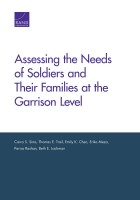| 来源类型 | Research Reports
|
| 规范类型 | 报告
|
| DOI | https://doi.org/10.7249/RR2148
|
| ISBN | 9780833099129
|
| 来源ID | RR-2148-A
|
| Assessing the Needs of Soldiers and Their Families at the Garrison Level |
| Carra S. Sims; Thomas E. Trail; Emily K. Chen; Erika Meza; Parisa Roshan; Beth E. Lachman
|
| 发表日期 | 2018
|
| 出版年 | 2018
|
| 页码 | 110
|
| 语种 | 英语
|
| 结论 |
Garrison problems generally reflected those at the army level.- In the garrison-level survey analysis, prioritized problem areas chosen by soldiers at a local level reflected the earlier Army-level analysis: military practices and culture, soldier's well-being, and work-life balance.
- Focus groups also highlighted health care system and childcare problems.
Garrison findings reflected variability in types of help needed.- The specific types of needs reported by soldiers varied among garrisons — but activities, information, and help provided by an actual person were most commonly reported.
Soldiers at different garrisons often sought help in different ways.- Fewer than 20 percent of respondents at any garrison reported that their needs were unmet.
- Focus groups highlighted military resources that are particularly helpful, including chaplains and Army Community Service.
Some tension exists between a desire for resilience and a desire to seek help.- Soldiers at all levels reported in focus groups that they wanted to — or should — be able to solve their problems themselves without needing to bring leadership into the equation.
- Focus groups revealed that individuals often do not realize that they need assistance until their challenges have become much more difficult to address.
Soldiers use a variety of methods to find out about resources to solve their problems, but barriers to resources were still a challenge.- The internet and word of mouth were the most common modes of finding out information.
- Focus groups revealed that lack of knowledge, lack of experience with resources, and limited hours of operation were commonly perceived barriers to resources.
|
| 摘要 |
- Resources providing one-on-one, personalized help should be given priority and it is possible that emphasizing trust between soldiers and their leaders could help fulfill this need.
- Providing easily accessible information online and staffing services that provide information to soldiers and their families should be continuing priorities for Army installations.
- In their intergovernmental support agreements and other community partnership activities, Army garrisons should consider focusing more on partnerships that help meet soldier and family needs because these partnerships offer creative ways to address some of the challenges faced.
- The Army might consider a series of solutions to achieve the right balance between fostering resilience and helping soldiers solve problems sooner. One solution is to expose noncommissioned officers and other soldiers earlier and more frequently in their careers to information regarding what resources are available. Another solution is to set priorities at the aggregate Army level, given the time available to soldiers, rather than leaving it up to lower levels to determine which of the many requirements passed down they must prioritize.
- The Army should consider strengthening the "no wrong door" policy at Army Community Service and broadening the policy to help soldiers and families navigate resources.
|
| 主题 | Health and Wellness Promotion
; Military Facilities
; Military Health and Health Care
; Military Spouses
; United States Army
|
| URL | https://www.rand.org/pubs/research_reports/RR2148.html
|
| 来源智库 | RAND Corporation (United States)
|
| 引用统计 |
|
| 资源类型 | 智库出版物
|
| 条目标识符 | http://119.78.100.153/handle/2XGU8XDN/108807
|
推荐引用方式
GB/T 7714 |
Carra S. Sims,Thomas E. Trail,Emily K. Chen,et al. Assessing the Needs of Soldiers and Their Families at the Garrison Level. 2018.
|
|
文件名:
|
x1532445121424.jpg
|
|
格式:
|
JPEG
|

|
文件名:
|
RAND_RR2148.pdf
|
|
格式:
|
Adobe PDF
|
除非特别说明,本系统中所有内容都受版权保护,并保留所有权利。